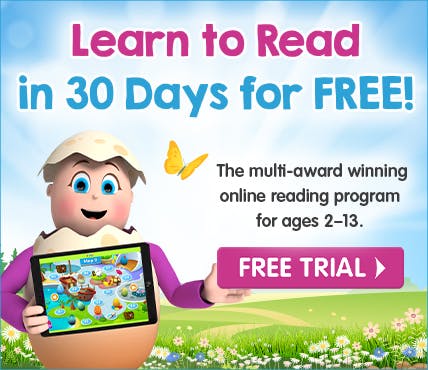


Strategies for Reading

Reading is a complex activity, requiring the reader to use countless skills simultaneously in order to read fluently. For both the child learning to read, and their parents, it can sometimes seem a thoroughly daunting task. And, knowing that a successful start in learning to read leads to further educational success, can make the task seem overwhelming.
It therefore helps to have strategies for reading in place, so that the seemingly insurmountable task of reading can be broken into parts, which somehow always seems less threatening.
According to the National Reading Panel’s report (2000), there are five essential elements to successful instruction:
Phonemic awareness
Phonics
Fluency
Vocabulary
Text comprehension
The Reading Eggs programme incorporates each of these five essential elements into the structure and content of its lessons. Each Reading Eggs lesson always includes four or five of these elements. What follows is a description of each literacy element, and the strategies for reading that Reading Eggs employs within each one.
Phonemic Awareness
A word is rarely just a single sound. Most words are made up of a number of smaller units of sounds, called phonemes. For instance, the simple word ‘cat’ is made up of three phonemes, /c/a/t/. Phonemic awareness is the ability to hear, identify, and manipulate those individual sounds in spoken words in order to use the phonemes like building blocks to make new words.
Reading Eggs concentrates on phonemic awareness early in the programme. Strategies for developing phonemic awareness include structured activities using:
Nursery rhymes
Listening skills
Sound play
Alphabet books.
These lessons engage young readers in activities that help their phonemic awareness to develop and flourish. Later on in the programme, readers listen to words in order to discern the lesson’s focus sound, and also work with onsets and rhymes, such as c-at, b-at, r-at, so that they become adept at breaking words into smaller parts. Being able to manipulate phonemes builds phonemic awareness skills, which when combined with phonics, rapidly increases a child’s bank of readable words.
Phonics
Phonics instruction helps beginning readers to link letters to sounds (phonemes) in order to form letter-sound correspondences and spelling patterns. Children can use this strategy in their reading, in order to see how letters and sounds relate.
Reading Eggs uses a synthetic phonics approach with lessons that map individual letters, or letter combinations, with their appropriate sound. Each letter of the alphabet is introduced in its own lesson which reinforces the relationship between letters and sounds. It also draws young readers’ attention to the alphabetic principle, that is, the notion that sounds relate directly to the letters of the alphabet.
Fluency
Fluency enables readers to quickly span the gap between recognising a word and understanding the meaning. It’s where the magic of reading takes place. Fluent readers spend less time sounding out and decoding words and more time on the meaning of a text. Researchers agree that repetition of reading activities is a very effective strategy for reading more fluently.
The Reading Eggs programme uses a range of strategies for reading fluently, such as:
Modelling the fluent reading of a book
Re-reading books
Comprehension activities
Vocabulary
Every child approaches reading with differing levels of vocabulary knowledge. Building a child’s bank of known words is a great strategy for improving reading.
Reading Eggs offers focused lessons that help build a child’s vocabulary, but also offers lessons in spelling as well. This not only builds vocabulary, but also helps kids know both how to spell a word, and how to use that word properly in a sentence. Instruction in these areas is another way that Reading Eggs offers kids great strategies for reading and writing.
Reading Eggs also accommodates children with a wide range of differing abilities; the programme is able to assist readers who may need extra help with vocabulary.
Text Comprehension
In order to comprehend a text, children should be taught how to:
Answer questions about a text
Ask questions of a text
Monitor their comprehension
Put a jumbled-up text back in order
Recognise story structure
Reading Eggs engages readers in all of the comprehension-building activities within a rich, enjoyable and rewarding learning environment. Reading Eggs creates a meaning-based approach to reading instruction in a way that engages and motivates readers, and offers them a host of effective strategies for reading that helps kids become fluent readers.
Testimonials
My children love Reading Eggs. They enjoy learning to read and spell with the lessons. My son struggled with other phonics programmes. But he loved Reading Eggs. Opening a new egg after each lesson kept him motivated to finish the programme.
- L. Taylor
Reading Eggs is a comprehensive, well-integrated programme, which I have found to be of great help in developing children’s skills and interest in reading. Even the senior students wanted to have a go!
- Lynne Brehaut, Nungurner Primary


